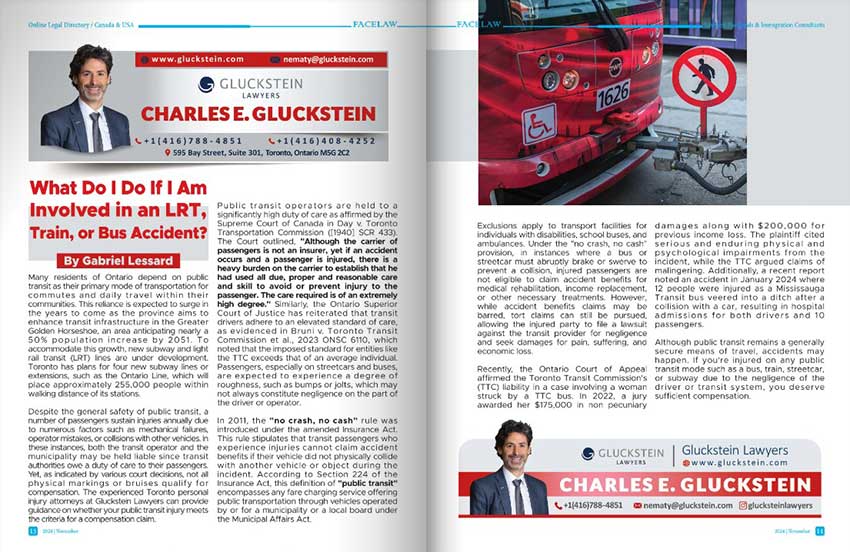What do I do if I am involved in an LRT, Train, or Bus accident?
What do I do if I am involved in an LRT, Train, or Bus accident?
By Gabriel Lessard
Many residents of Ontario depend on public transit as their primary mode of transportation for commutes and daily travel within their communities. This reliance is expected to surge in the years to come as the province aims to enhance transit infrastructure in the Greater Golden Horseshoe, an area anticipating nearly a 50% population increase by 2051. To accommodate this growth, new subway and light rail transit (LRT) lines are under development. Toronto has plans for four new subway lines or extensions, such as the Ontario Line, which will place approximately 255,000 people within walking distance of its stations.
Despite the general safety of public transit, a number of passengers sustain injuries annually due to numerous factors such as mechanical failures, operator mistakes, or collisions with other vehicles. In these instances, both the transit operator and the municipality may be held liable since transit authorities owe a duty of care to their passengers. Yet, as indicated by various court decisions, not all physical markings or bruises qualify for compensation. The experienced Toronto personal injury attorneys at Gluckstein Lawyers can provide guidance on whether your public transit injury meets the criteria for a compensation claim.
Public transit operators are held to a significantly high duty of care as affirmed by the Supreme Court of Canada in Day v. Toronto Transportation Commission ([1940] SCR 433). The Court outlined, "Although the carrier of passengers is not an insurer, yet if an accident occurs and a passenger is injured, there is a heavy burden on the carrier to establish that he had used all due, proper and reasonable care and skill to avoid or prevent injury to the passenger. The care required is of an extremely high degree." Similarly, the Ontario Superior Court of Justice has reiterated that transit drivers adhere to an elevated standard of care, as evidenced in Bruni v. Toronto Transit Commission et al., 2023 ONSC 6110, which noted that the imposed standard for entities like the TTC exceeds that of an average individual. Passengers, especially on streetcars and buses, are expected to experience a degree of roughness, such as bumps or jolts, which may not always constitute negligence on the part of the driver or operator.
In 2011, the "no crash, no cash" rule was introduced under the amended Insurance Act. This rule stipulates that transit passengers who experience injuries cannot claim accident benefits if their vehicle did not physically collide with another vehicle or object during the incident. According to Section 224 of the Insurance Act, this definition of "public transit" encompasses any fare-charging service offering public transportation through vehicles operated by or for a municipality or a local board under the Municipal Affairs Act. Exclusions apply to transport facilities for individuals with disabilities, school buses, and ambulances. Under the "no crash, no cash" provision, in instances where a bus or streetcar must abruptly brake or swerve to prevent a collision, injured passengers are not eligible to claim accident benefits for medical rehabilitation, income replacement, or other necessary treatments. However, while accident-benefits claims may be barred, tort claims can still be pursued, allowing the injured party to file a lawsuit against the transit provider for negligence and seek damages for pain, suffering, and economic loss.
Recently, the Ontario Court of Appeal affirmed the Toronto Transit Commission's (TTC) liability in a case involving a woman struck by a TTC bus. In 2022, a jury awarded her $175,000 in non-pecuniary damages along with $200,000 for previous income loss. The plaintiff cited serious and enduring physical and psychological impairments from the incident, while the TTC argued claims of malingering. Additionally, a recent report noted an accident in January 2024 where 12 people were injured as a Mississauga Transit bus veered into a ditch after a collision with a car, resulting in hospital admissions for both drivers and 10 passengers.
Although public transit remains a generally secure means of travel, accidents may happen. If you're injured on any public transit mode such as a bus, train, streetcar, or subway due to the negligence of the driver or transit system, you deserve sufficient compensation.



Click here to visit Charles E.Gluckstein’s Page for further information
brain injury lawyer in Canada
birth injury lawyer in Canada
slip and fall lawyer in Canada
personal injury lawyers in Canada
injury lawyer in Canada
long term disability lawyer in Canada
Medical malpractice lawyers in toronto
spinal cord injury lawyer in canada
accident lawyer in Toronto
car accident lawyer in Toronto
bicycle accident lawyer in GTA
Slip and Falls lawyer in GTA
Long term disability lawyer in Toronto


